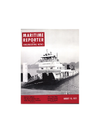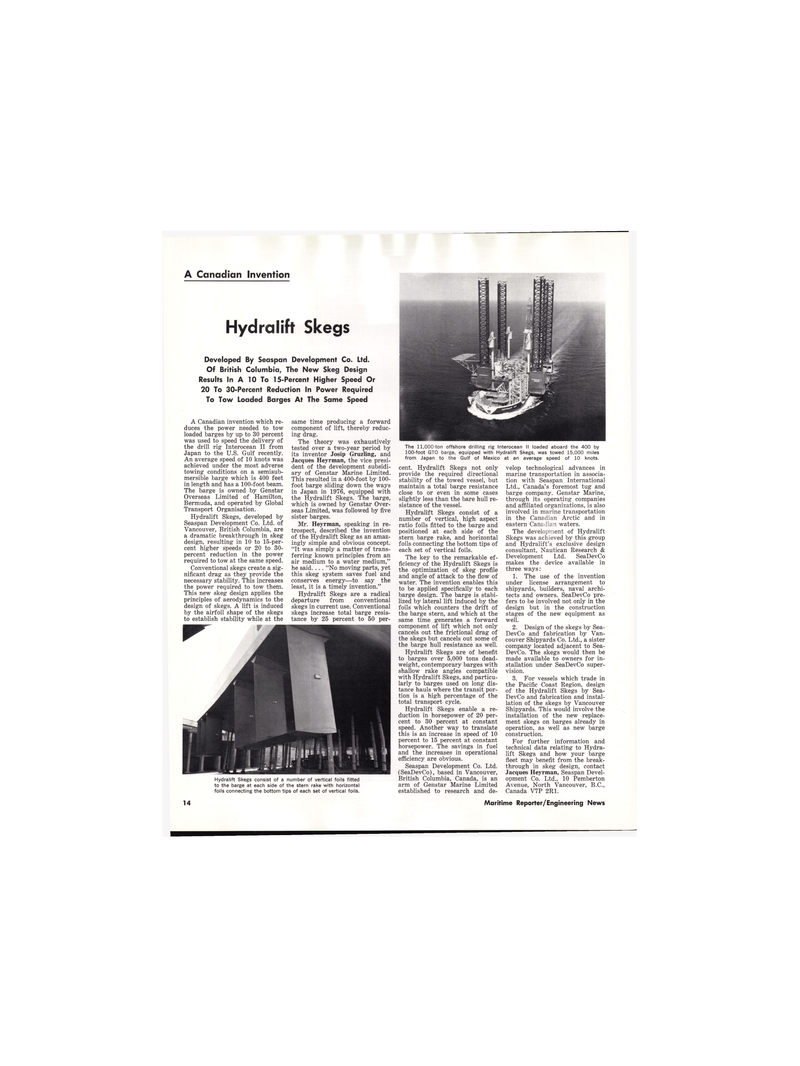
Page 14: of Maritime Reporter Magazine (August 15, 1977)
Read this page in Pdf, Flash or Html5 edition of August 15, 1977 Maritime Reporter Magazine
A Canadian Invention
Hydra lift Skegs
Developed By Seaspan Development Co. Ltd.
Of British Columbia, The New Skeg Design
Results In A 10 To 15-Percent Higher Speed Or 20 To 30-Percent Reduction In Power Required
To Tow Loaded Barges At The Same Speed
The 11,000-ton offshore drilling rig Interocean II loaded aboard the 400 by 100-foot GTO barge, equipped with Hydralift Skegs, was towed 15,000 miles from Japan to the Gulf of Mexico at an average speed of 10 knots.
A Canadian invention which re- duces the power needed to tow loaded barges by up to 30 percent was used to speed the delivery of the drill rig Interocean II from
Japan to the U.S. Gulf recently.
An average speed of 10 knots was achieved under the most adverse towing conditions on a semisub- mersible barge which is 400 feet in length and has a 100-foot beam.
The barge is owned by Genstar
Overseas Limited of Hamilton,
Bermuda, and operated by Global
Transport Organisation.
Hydralift Skegs, developed by
Seaspan Development Co. Ltd. of
Vancouver, British Columbia, are a dramatic breakthrough in skeg design, resulting in 10 to 15-per- cent higher speeds or 20 to 30- percent reduction in the power required to tow at the same speed.
Conventional skegs create a sig- nificant drag as they provide the necessary stability. This increases the power required to tow them.
This new skeg design applies the principles of aerodynamics to the design of skegs. A lift is induced by the airfoil shape of the skegs to establish stability while at the same time producing a forward component of lift, thereby reduc- ing drag.
The theory was exhaustively tested over a two-year period by its inventor Josip Gruzling, and
Jacques Heyrman, the vice presi- dent of the development subsidi- ary of Genstar Marine Limited.
This resulted in a 400-foot by 100- foot barge sliding down the ways in Japan in 1976, equipped with the Hydralift Skegs. The barge, which is owned by Genstar Over- seas Limited, was followed by five sister barges.
Mr. Heyrman, speaking in re- trospect, described the invention of the Hydralift Skeg as an amaz- ingly simple and obvious concept. "It was simply a matter of trans- ferring known principles from an air medium to a water medium," he said.. .. "No moving parts, yet this skeg system saves fuel and conserves energy—to say the least, it is a timely invention."
Hydralift Skegs are a radical departure from conventional skegs in current use. Conventional skegs increase total barge resis- tance by 25 percent to 50 per- cent. Hydralift Skegs not only provide the required directional stability of the towed vessel, but maintain a total barge resistance close to or even in some cases slightly less than the bare hull re- sistance of the vessel.
Hydralift Skegs consist of a number of vertical, high aspect ratio foils fitted to the barge and positioned at each side of the stern barge rake, and horizontal foils connecting the bottom tips of each set of vertical foils.
The key to the remarkable ef- ficiency of the Hydralift Skegs is the optimization of skeg profile and angle of attack to the flow of water. The invention enables this to be applied specifically to each barge design. The barge is stabi- lized by lateral lift induced by the foils which counters the drift of the barge stern, and which at the same time generates a forward component of lift which not only cancels out the frictional drag of the skegs but cancels out some of the barge hull resistance as well.
Hydralift Skegs are of benefit to barges over 5,000 tons dead- weight, contemporary barges with shallow rake angles compatible with Hydralift Skegs, and particu- larly to barges used on long dis- tance hauls where the transit por- tion is a high percentage of the total transport cycle.
Hydralift Skegs enable a re- duction in horsepower of 20 per- cent to 30 percent at constant speed. Another way to translate this is an increase in speed of 10 percent to 15 percent at constant horsepower. The savings in fuel and the increases in operational efficiency are obvious.
Seaspan Development Co. Ltd. (SeaDevCo), based in Vancouver,
British Columbia, Canada, is an arm of Genstar Marine Limited established to research and de- velop technological advances in marine transportation in associa- tion with Seaspan International
Ltd., Canada's foremost tug and barge company. Genstar Marine, through its operating companies and affiliated organizations, is also involved in marine transportation in the Canadian Arctic and in eastern Canadian waters.
The development of Hydralift
Skegs was achieved by this group and Hydralift's exclusive design consultant, Nautican Research &
Development Ltd. SeaDevCo makes the device available in three ways: 1. The use of the invention under license arrangement to shipyards, builders, naval archi- tects and owners. SeaDevCo pre- fers to be involved not only in the design but in the construction stages of the new equipment as well. 2. Design of the skegs by Sea-
DevCo and fabrication by Van- couver Shipyards Co. Ltd., a sister company located adjacent to Sea-
DevCo. The skegs would then be made available to owners for in- stallation under SeaDevCo super- vision. 3. For vessels which trade in the Pacific Coast Region, design of the Hydralift Skegs by Sea-
DevCo and fabrication and instal- lation of the skegs by Vancouver
Shipyards. This would involve the installation of the new replace- ment skegs on barges already in operation, as well as new barge construction.
For further information and technical data relating to Hydra- lift Skegs and how your barge fleet may benefit from the break- through in skeg design, contact
Jacques Heyrman, Seaspan Devel- opment Co. Ltd., 10 Pemberton
Avenue, North Vancouver, B.C.,
Canada V7P 2R1. 14 Maritime Reporter/Engineering News

 13
13

 15
15
